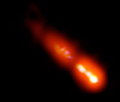 Tutors: Alessandro Caccianiga, Alberto Moretti, Fabrizio Tavecchio - INAF-OAB Milano
Tutors: Alessandro Caccianiga, Alberto Moretti, Fabrizio Tavecchio - INAF-OAB Milano
Lasting: 3 years. PhD thesis.
Supermassive black holes (SMBH), with masses reaching several billions of solar masses (Msun), are present in the center of nearly all galaxies. Current theoretical models assume that they formed relatively "light" (102-104 Msun) when the Universe was ∼300-500 Myr old and then rapidly accreted matter to reach the huge masses observed today. However, the observation of galaxies in the early Universe (less than 1 Gyr old) hosting already massive SMBH (∼109 Msun) is a challenge for current models, since the time available for the black-hole growth was very short. For this reason, searching and studying SMBH in the early Universe, in particular those actively accreting matter (the so-called quasars), is a lively and hot topic in current astrophysical research.
A general review on this topic can be found here: https://arxiv.org/abs/2110.10175v1
Our research group, currently including 4 staff researchers, 1 PhD student and 1 post-doc, has been actively working in this important research field in the last 5 years. In particular we have been focused on the enigmatic sub-set of quasars that are able to produce powerful relativistic jets (the so-called "radio-loud quasars") in order to establish their actual role in the overall picture.
The list of publications of our group on this research field in the last 3 years can be found here:
http://www.brera.mi.astro.it/~alessandro.caccianiga/highz_pub.html
In this thesis we offer to the PhD student the possibility of taking a leading role on some specific aspects of this stimulating field either by exploiting the large amount of data we have collected so far and/or obtaining new data set by writing specific proposals. The PhD student will also have the possibility of spending one or more periods abroad to gain expertise and foster external collaborations.
The (non-exhaustive) list of possible lines of reasearch to be carried out includes:
-
The quest for relativistic jets at the Dawn of Cosmic time: this research project is aimed at the discovery and the physical characterisation of relativistic jets produced by accreting super Massive Black-Holes (Quasars) in the Early Universe i.e. during its first ∼1 Billion of years of life. The goal is to assess the role of these intriguing (and still poorly understood) structures in the evolution of Super-Massive Black-holes across the Cosmic time. This kind of research can now benefit of a huge amount of data coming from the new generation of telescopes working across the entire electromagnetic spectrum, from the radio wavelengths (e.g. ASKAP-EMU), to the optical/IR band (Vera Rubin Observatory-LSST) up to the X-ray energies (eROSITA-eRASS1). We expect that, with these new data, it will be possible to discover several Quasars with relativistic jets at redshift above ∼6 or even above redshift ∼7, a currently unexplored territory for this type of astrophysical sources. The analysis is expected to be focused not only on the properties of the discovered high redshift jetted Quasars but also to the comparison with Quasars at similar red-shifts, but without relativistic jets and, at the same time, with jetted Quasars but in the local Universe. These comparisons will provide fundamental information to understand the role of relativistic jets in the global evolutionary picture of accreting super-massive Black-Holes.
Our group has a very good expertise in this field as demonstrated by the fact that more than half of jetted Quasars at redshift above 6 has been discovered by PhD students from our group. Therefore, the student will have the unique opportunity to carry out her/his own research in a very stimulating research field, with the full support of an expert team.
SUGGESTED PAPERS:
https://academic.oup.com/mnras/article/484/1/204/5270742
https://www.aanda.org/articles/aa/full_html/2021/03/aa40362-21/aa40362-21.html
https://www.aanda.org/articles/aa/full_html/2020/03/aa37395-19/aa37395-19.html
- Extended X-ray jets: the relativistic jets departing from radio-loud Quasars, in some cases extend over tens of kpc and are directly observable as resolved structures at different wavelengths. In particular, the X-ray emission of these objects is particular intriguing for, at least, two reasons. First, the physical mechanism responsible for this emission is unclear and has been debated for over two decades. Second, current observations show that their properties evolve with redshift. Starting from the observation of the most distant extended object ever observed (at redshift z=6.1), in a recent work conducted by a PhD student of our group, we interpreted these phenomena as due to the interaction of the jet electrons with the CMB radiation which is much denser in the early Universe. However, since this explanation is contentious, an extensive comparison of the model predictions with larger datasets would be very useful for testing the presented model. This is a suitable PhD thesis in a forefront research field for a student who would like to complement the analysis of observational data with a more theoretical approach.
SUGGESTED PAPERS:
https://arxiv.org/abs/2111.08632
https://www.mdpi.com/2075-4434/4/4/65
https://iopscience.iop.org/article/10.3847/1538-4357/aa907a/pdf
|
 Tutors: Alessandro Caccianiga, Alberto Moretti, Fabrizio Tavecchio - INAF-OAB Milano
Tutors: Alessandro Caccianiga, Alberto Moretti, Fabrizio Tavecchio - INAF-OAB Milano